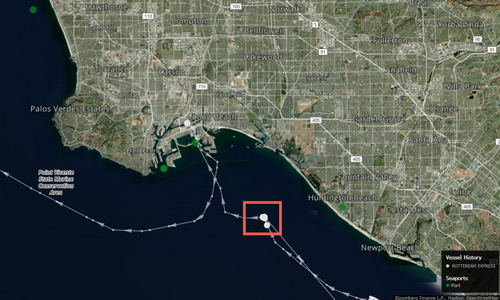Hapag-Lloyd, the shipping company that operates the container ship, confirmed Thursday morning that investigators boarded the ship Wednesday while moored at the Port of Oakland. The company stands by its claims that it played no part in the oil spill.
"We are fully cooperating with the authorities at this moment," said Nils Haupt, a spokesman at Hapag-Lloyd's headquarters in Hamburg, Germany.
* * *
Data compiled by MarineTraffic, a navigation service that tracks vessel locations, shows a massive containership was anchored near a Southern California oil pipeline before it ruptured.
We noted Tuesday the Coast Guard is investigating whether a ship's anchor might have punctured Amplify Energy Corp.'s undersea pipeline off the coast of Orange County, California, creating one of the state's worst oil spills in three decades.
Reviewing more than two weeks of data from MarineTraffic, AP said vessel data shows the massive Rotterdam Express, a German-flagged container ship, was closest to where the pipeline ruptured off Huntington Beach.
On Sept. 22, Rotterdam Express arrived outside the Port of Long Beach and dropped anchor about 2,000 feet from the pipeline. The following day, data shows the vessel drifted over the pipeline resting on the seafloor about 100 feet below the surface. The ship had to correct its position several times to move back to its original anchoring spot. By last Sunday, the vessel moved into the Port of Long Beach to unload.

The first oil spill report occurred on Friday evening, and Amplify was able to shut down the pipeline by Saturday morning. But during the rupture, more than 126,000 gallons of post-production crude leaked into the ocean and ended up on Orange County's beaches by late Saturday night.
Amplify's CEO Martyn Willsher noted Tuesday that divers determined that 4,000-feet of the pipeline was dislodged 105 feet from its original spot.
However, Hapag-Lloyd, the shipping company that operates the Rotterdam Express, told AP that MarineTraffic data is wrong and the vessel "did not move."
"We have proof by the logbook, which is updated hourly, that the vessel did not move," Nils Haupt, a spokesman for Hapag-Lloyd in Hamburg, Germany, said. "MarineTraffic, in this case, is wrong, and the position is indeed incorrect."
Nikolas Xiros, a professor of marine engineering at the University of New Orleans, said it would be doubtful that the transponder data for a vessel, which operates through a global network called the Automatic Identification System, would be wrong by thousands of feet.
"AIS transporters are very accurate and the whole system is also very accurate," Xiros said after reviewing location data for Rotterdam Express. "I think probably the ship moved, that's what I think. And with the anchor down, which was a big problem."
He said there's no reason the ship could've moved so far from its initial anchored position because the seas were calm.
"There is a series of peculiar things and all that need to be explained," Xiros said. "It may very well be some kind of an accident, but not necessarily a human error. We will have to see. But … I think he most probable explanation is the ship with anchor down moved both back and forth and possibly caused damage to the pipeline."
The mystery remains on what exactly caused one of the worst oil spills in California's history, but investigators appear to be getting closer to the source.




No comments:
Post a Comment